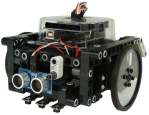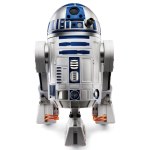For as prescient as Gene Roddenberry was in Star Trek: The Original Series, the presence of robots was remarkably absent. Later, in Star Trek: The Next Generation, robots rarely appeared as regular every devices. Sure, there was Data, and his brother, Lore, and then later the Borg were introduced, but there were never robots swerving among crew members doing frak-knows-what. In fact, the Star Trek Universe is remarkably devoid of robots for all cultures and planets, pretty much. We have to teleport to the Star Wars Universe to find robots aiding and abetting humans and aliens alike.
I was ruminating the other day. I share my building with the Department of Physics. Except our Department of Physics is not longer called the "Department of Physics." As of this month, the department is now referred to as the "Department of Engineering and Physics." The Physics folks have fallen victim to the lack of interest Americans have in the hard sciences, and why the White House is trying to encourage Congress not to send home the foreign nationals who come to the United States for their science education. But, that is a rant for a different day.
Bypassing the elevators for the stairs I noticed a poster. The poster contained many pics taken from a recent robot-making faire from the Spring 2013 semester. Local middle- and high school students were encouraged to visit campus for a Robot Weekend Open House. The pics showed several college students hunkered over boxes containing little wheeled robots. The robots appeared poised to navigate a maze constructed within the boxes. Nearby, the local middle and high school students perched to observe the success or failure of the little robots.
The pics were accompanied by annotation. To the project's credit, Arduino boards were used in robot development. I think I saw Raspberry Pi mentioned, as well. The poster communicated how the robots would "sense" the environment. Infrared sensors were placed at strategic places on the robot's perimeter. The sensors would return a signal to a processor, a signal based on voltages. A voltage drop or rise indicated a change in direction, for example.
My sentiment is all universities should be pushing the boundaries of technology. Regional universities are typically restricted from becoming full-fledged research institutions. Flagship schools do not want their academic territory trod upon. For instance, University of North Carolina (Chapel Hill) is a flagship research university for North Carolina. North Carolina also has Duke University (Durham). For a state to have a couple research universities is not uncommon. Missouri has several, actually. Kentucky has two, University of Louisville and University of Kentucky. Some states control research at state schools by controlling the funding the school receives and by controlling access to doctoral programs. In Kentucky, for example, regional state schools cannot develop a doctoral program without the express consent of the KY Council on Post-secondary Education (CPE).
I find this embargo on research at regional universities a self-defeating tactic of politician and policy-makers who claim to want to expose more people to research, science, and technology. Universities are a very active source of research which spills over into patents. Sometimes, the licensing of these patents can help fund more research. Research generally involves putting students to work. Research can help reduce costs to students by providing the necessary funds for maintaining expensive research laboratories, by providing grants and scholarships, and by simply providing a means of employment.
Many companies, like Google (Stanford), get started within a university environment. The nature of entrepreneurial endeavors then create a ripe, robust, and exciting atmosphere for pushing the educational envelop. Steve Jobs may not have graduated from college but he certainly hired hundreds of college grads. Bill Gates, too. Universities are one of the best atmospheres to tap into youthful exuberance, the desire to learn real and necessary skills, and to build intellectual networks.
Too bad Congress is so ridiculously dim-witted and unable to fathom any of this.
The poster on the first floor of my building irritated me, though. In 1985 I was in high school. My electronics teacher was a good guy, a bit of a pushover, but he really enjoyed teaching electronics. He presented each us with an opportunity to buy a robot kit. The kit would come with a bunch of parts we would solder to a motherboard. If the robot was assembled correctly and none of the necessary circuits melted in the soldering process, the robot would following a black line drawn on a piece of white butcher paper. As we would discover later, the robot would also follow the seams between tiles on our classroom floor.
 But, this was in 1985. In 2013, we are still building these clumsy robots which try to navigate a 6' x 6' box inlaid with a series of barriers to create a maze for the robot to navigate. Twenty-eight years later, I'm not really impressed, honestly. I expect more from my university and college, actually.
But, this was in 1985. In 2013, we are still building these clumsy robots which try to navigate a 6' x 6' box inlaid with a series of barriers to create a maze for the robot to navigate. Twenty-eight years later, I'm not really impressed, honestly. I expect more from my university and college, actually.
Arduino boards are a good start. Raspberry Pi is awesome. What is already coming down the pike towards us has to do with robots and mapping and using robots to do mapping. I'm not referring to drone mapping. I've covered some of those applications in other posts.
We are all by now pretty aware of what GPS (global positioning systems) allows us to do, even if we don't understand how GPS works. We have some idea because of our iPhones and Android-based phones embedded with mapping apps, or social apps with a mapping component. Have you heard of IPS, though?
IPS stands for "interior/indoor positioning systems." IPS works just like GPS works for mapping roads. Road mapping is performed by a car, truck, or van, equipped with an accurate GPS transceiver. Roads are driven and the GPS collects points along about every 1-3 seconds and then software is used to connect the dots to form a line to represent the road. Analysts then post-process the data, creating a database table tied to the digital road data. The database table contains all the pertinent info about the road, the address range, road type, width, age, date of last resurface, road class (local, county, city, state highway, US highway, federal highway).
IPS doesn't use GPS, though it can, and may use GPS as a way to refine inside position. IPS uses indoor wireless and sensors built into the robot. The robot become the car from the discussion above, driving through hallways and building a hallway map for a given building. Road maps are derived from an imaginary line called the "road centerline," the hypothetical geometric center of the road. IPS generates a "hallway centerline" to which attributes can be attached, such as room numbers, hallway width, or hallway height.
 IPS does not require a robot to build the map. A building's blueprints can be scanned and adapted for use. I like the idea of a robot, a 'droid, though. I like the idea because I like the notion of having a 'droid follow me around, helping me move computers and accessories from room to room.
IPS does not require a robot to build the map. A building's blueprints can be scanned and adapted for use. I like the idea of a robot, a 'droid, though. I like the idea because I like the notion of having a 'droid follow me around, helping me move computers and accessories from room to room.
We have the capability of doing this. Take one of those electric Barbie cars for kids younger than 8 sold at Toys R Us, for instance. Remove all the Barbie stuff so only the electronics remain. Add an Arduino or Raspberry Pi board for the brains and some actuators for controlling the steering and speed of the 'droid.
I'd like to see something like this, a full-fledged working 'droid, capable of navigating a hallway and following a particular user, perhaps even able to follow voice commands, a la Siri. All of the components exist.
Now, go get busy and make me an R2-D2 unit :)
Pax
Related articles
- 11 Arduino projects that require major hacking skills—or a bit of insanity (arstechnica.com)
- Now Available in the Maker Shed: The New Arduino Robot! (makezine.com)
- Here's What People Are Actually Using That $35 'Raspberry Pi' Computer For (businessinsider.com)
- New technique helps robotic vehicles find their way (rdmag.com)
- Researchers control flying robot with only the mind (rdmag.com)
- Firefighting robot paints 3-D thermal imaging picture for rescuers (rdmag.com)
- Militaries' growing use of ground robots raises ethics concerns (stripes.com)
No comments:
Post a Comment